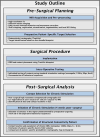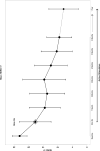A connectomic approach for subcallosal cingulate deep brain stimulation surgery: prospective targeting in treatment-resistant depression
- PMID: 28397839
- PMCID: PMC5636645
- DOI: 10.1038/mp.2017.59
A connectomic approach for subcallosal cingulate deep brain stimulation surgery: prospective targeting in treatment-resistant depression
Abstract
Target identification and contact selection are known contributors to variability in efficacy across different clinical indications of deep brain stimulation surgery. A retrospective analysis of responders to subcallosal cingulate deep brain stimulation (SCC DBS) for depression demonstrated the common impact of the electrical stimulation on a stereotypic connectome of converging white matter bundles (forceps minor, uncinate fasciculus, cingulum and fronto-striatal fibers). To test the utility of a prospective connectomic approach for SCC DBS surgery, this pilot study used the four-bundle tractography 'connectome blueprint' to plan surgical targeting in 11 participants with treatment-resistant depression. Before surgery, targets were selected individually using deterministic tractography. Selection of contacts for chronic stimulation was made by matching the post-operative probabilistic tractography map to the pre-surgical deterministic tractography map for each subject. Intraoperative behavioral responses were used as a secondary verification of location. A probabilistic tract map of all participants demonstrated inclusion of the four bundles as intended, matching the connectome blueprint previously defined. Eight of 11 patients (72.7%) were responders and 5 were remitters after 6 months of open-label stimulation. At one year, 9 of 11 patients (81.8%) were responders, with 6 of them in remission. These results support the utility of a group probabilistic tractography map as a connectome blueprint for individualized, patient-specific, deterministic tractography targeting, confirming retrospective findings previously published. This new method represents a connectomic approach to guide future SCC DBS studies.
Conflict of interest statement
Disclosures: Patricio Riva-Posse reported no biomedical financial interests or potential conflicts of interest. Ki Sueng Choi reported no biomedical financial interests or potential conflicts of interest. Paul E. Holtzheimer reported serving as a paid consultant to St Jude Medical Corp. Andrea L. Crowell reported no biomedical financial interests or potential conflicts of interest. Steven J. Garlow reported no biomedical financial interests or potential conflicts of interest. Justin K. Rajendra reported no biomedical financial interests or potential conflicts of interest. Robert E. Gross reported receiving grants from Medtronic Inc., Neuropace and MRI Interventions, honoraria from Medtronic Inc and MRI Interventions; and serving as a paid consultant to St Jude Medical Corp., Medtronic Inc., Neuropace, MRI Intervantions, Neuralstem and SanBio. Cameron C. McIntyre is a paid consultant for Boston Scientific Neuromodulation, and is a shareholder in the following companies: Surgical Information Sciences, Inc.; Autonomic Technologies, Inc.; Cardionomic, Inc.; Enspire DBS, Inc.; Neuros Medical, Inc. Helen S. Mayberg has a consulting agreement with St Jude Medical, Inc., which has licensed her intellectual property to develop SCC DBS for the treatment of severe depression (US 2005/0033379A1). Medtronic and St Jude Medical Corp develop products related to the research described in this article. The terms of these arrangements have been reviewed and approved by Emory University in accordance with their conflict of interest policies. Helen Mayberg had no role in patient selection, clinical ratings or access to raw patient data.
Figures
References
-
- Mayberg HS, Lozano AM, Voon V, McNeely HE, Seminowicz D, Hamani C, et al. Deep brain stimulation for treatment-resistant depression. Neuron. 2005;45(5):651–60. - PubMed
-
- Lozano AM, Mayberg HS, Giacobbe P, Hamani C, Craddock RC, Kennedy SH. Subcallosal cingulate gyrus deep brain stimulation for treatment-resistant depression. Biological psychiatry. 2008;64(6):461–7. - PubMed
-
- Bewernick BH, Hurlemann R, Matusch A, Kayser S, Grubert C, Hadrysiewicz B, et al. Nucleus accumbens deep brain stimulation decreases ratings of depression and anxiety in treatment-resistant depression. Biological psychiatry. 2010;67(2):110–6. - PubMed
-
- Sartorius A, Henn FA. Deep brain stimulation of the lateral habenula in treatment resistant major depression. Medical hypotheses. 2007;69(6):1305–8. - PubMed
Publication types
MeSH terms
Grants and funding
LinkOut - more resources
Full Text Sources
Other Literature Sources
Medical
Research Materials





